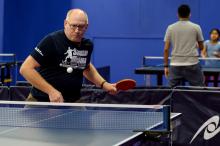Targeting the Transition
“You need to attack his middle.”
“I recommend that you play 80% of your hits to his transition point.”
“Hunt the elbow – play the elbow – your opponent gets jammed easily!”
Over and over again, I hear coaches at tournaments wisely reminding their students about the importance of ball placement, especially placement to the middle transition ball to jam the opponent. However, these same coaches never give their students SPECIFIC drills in the training hall to help to learn to find the middle and attack the middle. In this article, I’m going to give you the reasons for attacking the middle then a few drills that might help you get started.
The Reason
Table tennis should be played automatically, almost unconsciously. Between points, it is important to do much thinking as far as processing the previous point and forming new tactics, but in the heat of the point, you should relax and let it happen. Too much thinking during the point will hinder your progress. When your opponent plays to your forehand, then it is simple, your body knows to play a forehand, it doesn’t require much thought. Same thing with the backhand. However, when your opponent hits your middle transition ball, you need to make a decision… Hmm…. Should I step quickly to the side and use a forehand or step quickly to the other side and use a backhand??? This decision that needs to be made often causes you to lose positioning and timing therefore you are forced to hit a lower percentage shot with a lower quality hit. I could literally continue for five more pages on this topic, but I’m going to spare you from a long reading. Just remember this, the middle transition ball between backhand and forehand is one of the main targets that you should be hitting; however, this skill will never reach its peak potential unless it is trained!
Drills
I have developed many, many, many drills for attacking, defending, serving, and receiving against the middle transition ball. However, I’m only going to list three drills here today. Once you have performed these three drills for a few weeks, you will then be targeting the middle about twice as often in games and you will understand that ball placement needs to be developed in the training hall, not just in the classroom.
#1 Player A blocks to the middle transition point. Player B attacks to the middle transition point. The goal for the drill is never to allow the opponent to hit more than 1-2 backhands or forehands; in order to do this, both players need to be aware of where they hit and which side was used by their opponent. For example, if the opponent used a backhand from the centerline, then the next ball needs to be placed slightly more to the forehand. If the opponent used another backhand, then the next ball again needs to be even more to the forehand. Should you watch the incoming ball or your opponent? Both! You should be specifically seeing the incoming ball while being able to slightly see your opponent with your peripheral vision.
#2 Player A blocks to player’s B’s 75% forehand zone. Player B plays all forehand. Player B plays one ball to the wide backhand and one ball to the wide forehand. Anytime that play B chooses, he attacks the middle transition point then it becomes free point.
#3 Player A blocks anywhere on the table. Player B attacks two balls to the wide backhand, two balls to the wide forehand, then one ball to the middle transition point. The drill continues in that pattern. You can also start this (or any other drill) with a serve. Player A serves, players B loops or flips, then the drill begins. As you get closer and closer to your next tournament, you should begin the majority of the drills with a serve. Drill are NOT meant to improve your practice. Drills are meant to improve your match performance.
I hope that these three drills will be helpful. Once you understand the concepts of these three drills, it will then be easier for you to design dozens of your own drills designed to perfect this skill!!!
Targeting the Transition

Check out these new drills!
Category:



